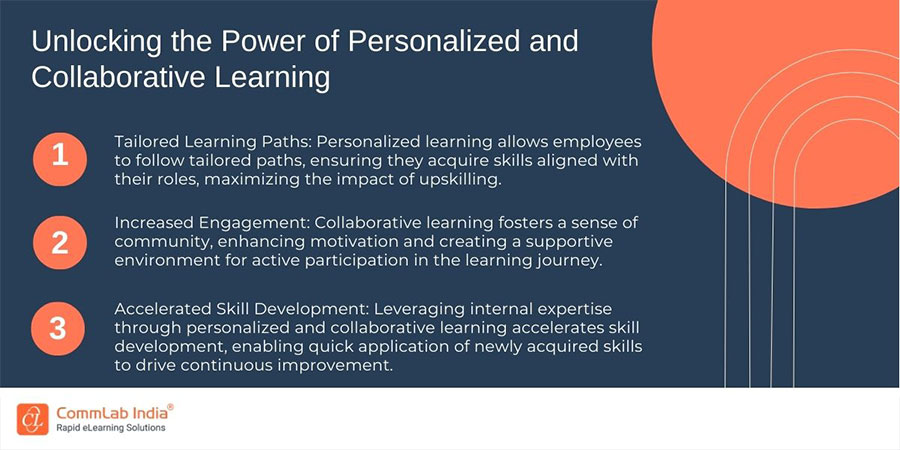Maximize Profits: 7 Upskilling & Reskilling Strategies for Business Growth

In the fast-paced landscape of today’s business, staying ahead requires more than just routine tasks. Picture this scenario: your industry is evolving, technologies are advancing, and market demands are shifting. Your workforce, however, may be grappling with outdated skills or lacking expertise in emerging areas critical to your business. To tackle this challenge, embracing a robust upskilling and reskilling strategy becomes extremely important.In this blog, we will discuss seven professional upskilling and reskilling strategies to not only keep your team relevant but also to propel your business towards sustained, long-term growth.
Upskilling and Reskilling are Key for Business Success!
Upskilling and reskilling are pivotal in ensuring a workforce's adaptability and competitiveness. In a rapidly evolving business landscape, these strategies empower employees with new skills, fostering innovation, increasing productivity, and ensuring an organization's resilience. Investing in continual learning is key to staying ahead and achieving sustained success.
Empowering employees with upskilling and reskilling strategies ensures they stay agile and future-ready in an ever-evolving professional landscape. Here are some benefits of employee upskilling and reskilling:

Let us now discuss key upskilling and reskilling strategies to boost profits and business growth.
7 Upskilling & Reskilling Strategies for Business Growth and Profits
1. Assess Current Skill Gaps Using Microlearning
Assessing your employees' current skill sets is the first step toward strategic upskilling and reskilling. Microlearning is one of the best solutions to do so. By employing microlearning, conduct a comprehensive skills assessment across the organization. Identify existing gaps and anticipate future needs aligned with your business objectives. This microlearning approach ensures targeted and easily digestible training content.
Example: Utilize microlearning modules to assess and address specific coding language proficiency gaps within your development team.
2. Tailor Custom eLearning to Business Objectives
To align your upskilling efforts with specific business goals, leverage custom eLearning programs. This strategic approach ensures that the acquired skills directly contribute to the company's success. Whether aiming to enhance customer service, improve product development, or streamline operations, custom eLearning offers tailored solutions.
Example: Develop a custom eLearning course focusing on advanced data analysis for employees contributing to business intelligence, aligning their skills with the organization's analytical goals.
3. Leverage Online Learning Platforms for Virtual Training
To enhance employee skills, implement virtual training sessions on project management principles using an online learning platform. Platforms like LinkedIn Learning, Coursera, or industry-specific platforms provide a plethora of courses covering diverse topics. Encourage employees to engage in continuous virtual learning, fostering a culture of self-directed upskilling, and contribute to employees' professional growth.
Example: Implement virtual training sessions on project management principles using an online learning platform.
→ Download Now: Online Learning for Corporate Training [eBook]
4. Promote Cross-Functional Training with Gamification
Promote a culture of continuous learning and cross-functional expertise through gamified training experiences. Implementing a gamification twist to cross-functional training not only equips employees with a diverse skill set but also enhances engagement.
Example: Introduce a gamified program where employees earn points and badges upon completing various skill modules. This not only adds an element of fun to the learning process but also motivates employees to actively participate in acquiring new skills.
5. Implement Mentorship Programs for Personalized Learning
Cultivate a culture of knowledge sharing by implementing mentorship programs within your organization. These programs focus on personalized learning, allowing experienced employees to guide their peers by sharing insights and best practices. This personalized and collaborative approach accelerates the upskilling process, creating an environment where employees can thrive.
Here is why personalized approach is important:

Example: Consider implementing a mentorship program where seasoned mentors provide personalized guidance tailored to individual learning needs. This not only enhances the learning experience but also ensures that employees receive targeted support in their upskilling journey.
6. Encourage Continuous Feedback through Interactive Assessments
Establishing a robust feedback loop is crucial for assessing the effectiveness of upskilling initiatives. Utilize interactive assessments as a means to regularly gather input from employees about their learning experiences and the applicability of acquired skills. This ongoing feedback mechanism, facilitated through interactive platforms, allows organizations to adapt and fine-tune the training approach, ensuring sustained relevance.
Example: Integrate interactive assessments at the conclusion of each module, providing a real-time avenue for employees to share insights on the effectiveness of the upskilling program.
7. Recognize and Reward Progress with Badges and Certifications
Acknowledge and celebrate the achievements of employees who actively participate in upskilling and reskilling programs with badges and certifications. Implement a recognition system or rewards, making use of gamification elements to motivate continuous learning. This fosters a positive learning culture within the organization.
Example: Issue digital badges or certifications for completing specific upskilling milestones, creating a sense of accomplishment.
Watch this video for tips on how to make your corporate upskilling and reskilling programs more impactful:
Wrapping Up
In conclusion, a strategic focus on upskilling and reskilling, enhanced by microlearning, custom eLearning, virtual training, and gamification, is not just an investment in your employees; it's an investment in the future success of your business. By aligning training efforts with business objectives, leveraging diverse learning platforms, and fostering a culture of continuous learning, you position your team and organization for sustained growth and prosperity. Maximize profits by maximizing the potential of your workforce through strategic upskilling and reskilling initiatives.
Ready to explore online learning to upskill and reskill your employees? Its a great decision that will transform your business. Download our comprehensive eBook: “Download eBook: Online Learning for Corporate Training” for more guidance.
Download Now!



![7 Ways to Upskill and Reskill the Manufacturing Workforce [Infographic]](https://blog.commlabindia.com/hubfs/blogs/manufacturing-sector-digital-upskilling-infographic%20.jpg)

